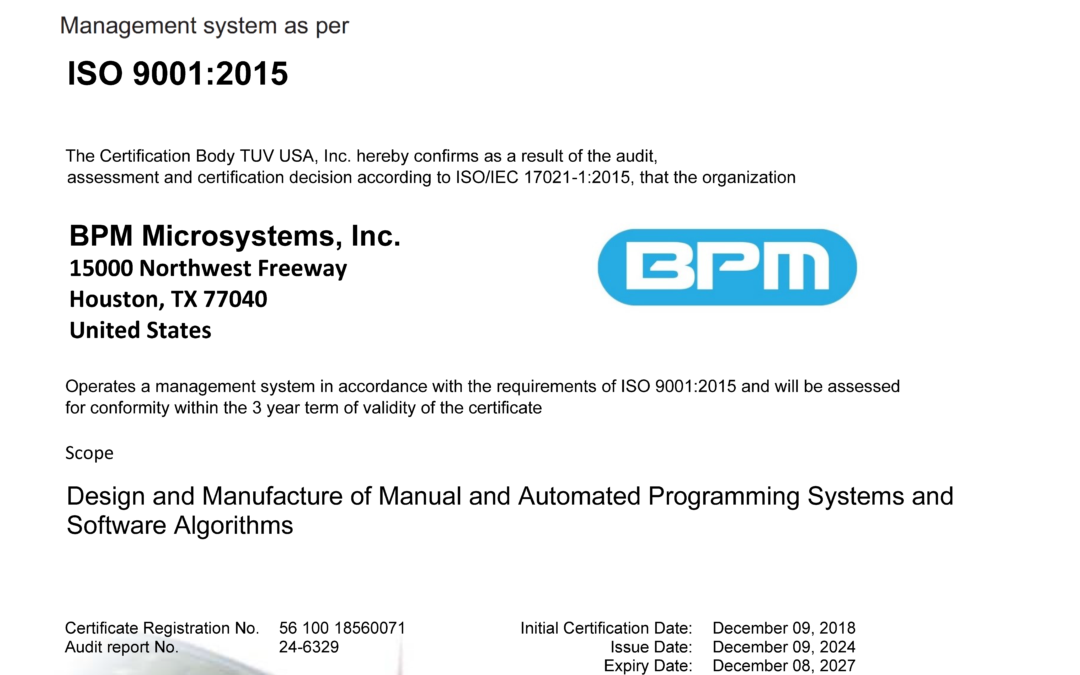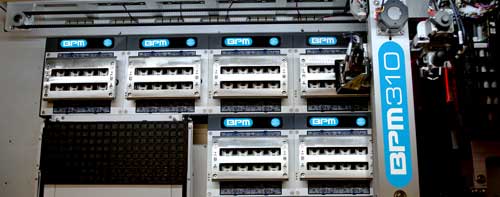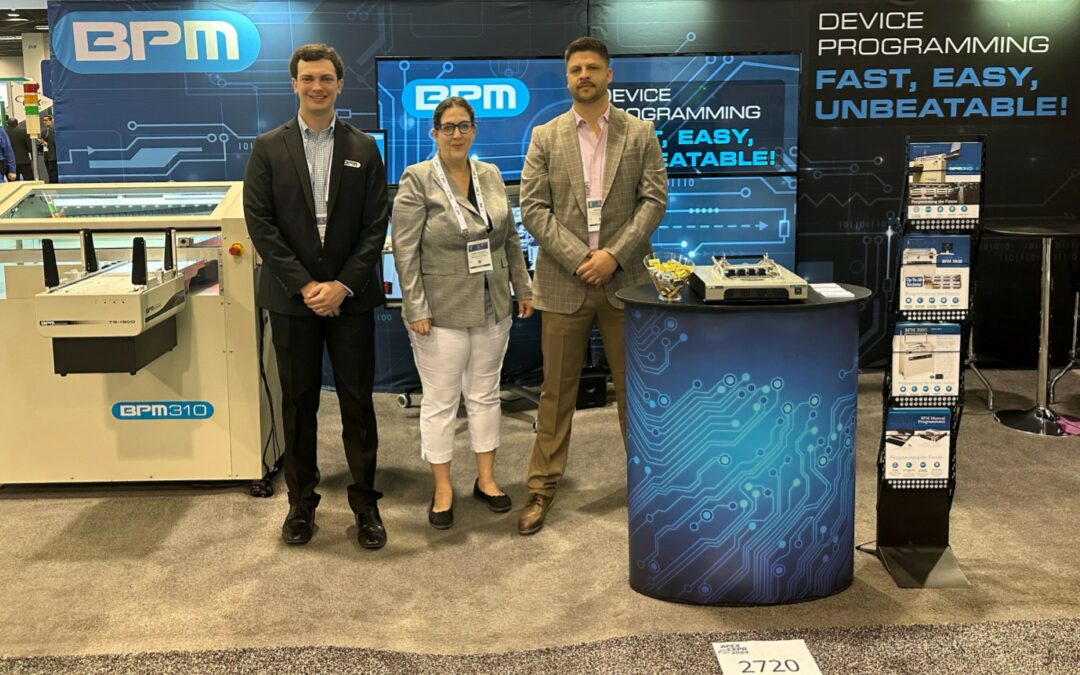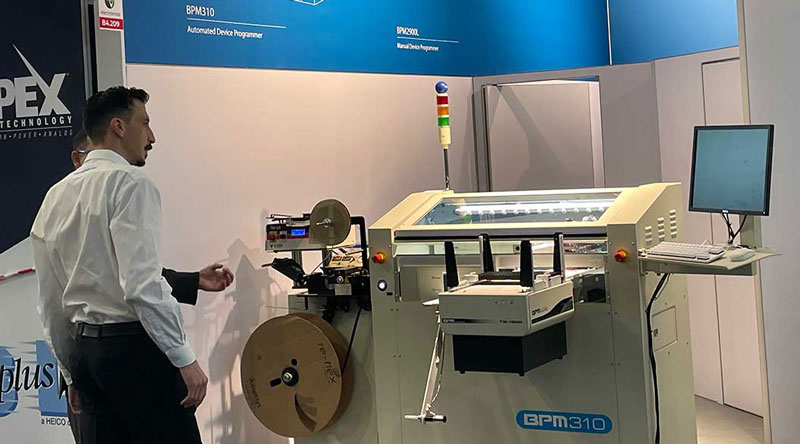by Colin Harper | Feb 12, 2025 | News
FOR IMMEDIATE RELEASE
BPM Microsystems Celebrates 40 Years of Innovation in Device Programming
Houston, TX – February 12, 2025 – BPM Microsystems, a global leader in automated device programming solutions, proudly celebrates its 40th anniversary in 2025. Since its founding in 1985, BPM has pioneered cutting-edge programming technology, transforming the semiconductor programming industry and empowering electronics manufacturers worldwide.
A Legacy of Innovation
BPM Microsystems was founded in Houston, Texas, with a vision to revolutionize device programming by making it faster, more precise, and highly efficient. Over the past four decades, BPM has consistently set new standards in quality, reliability, and performance. The company introduced the industry’s first universal device programmer in 1992, enabling manufacturers to program multiple device technologies with a single machine.
In the mid-1990s, BPM pioneered high-speed automated programming systems by combining universal programming technology with fine-pitch placement and repeatability. This innovation paved the way for the groundbreaking 7th, 9th, and 10th Generation technologies, which have continued to set industry benchmarks and have collectively programmed billions of devices over the years. The release of the BPM310 in 2021 further cemented BPM’s position as a leader in automated programming, delivering unmatched flexibility, speed, and scalability in a compact footprint. In 2024, BPM introduced the BPM210, a Semi-Automatic Universal Desktop Programmer, establishing a new product category that bridges the gap between manual and automated programming solutions.
Who Depends on BPM Microsystems?
BPM Microsystems’ solutions power mission-critical applications that impact practically every person on the planet. From automobiles and smartphones to Internet routers, satellites, and life-saving medical equipment, our products ensure the reliable operation of essential technology.
“When you think about the consequences of even a single device failing to operate properly in an airbag circuit, a pacemaker, or an autopilot, you see why we care so much,” said William H. White, Founder, President, and CEO of BPM Microsystems. “Our customers know that when it absolutely has to be programmed correctly, you turn to BPM Microsystems for solutions. Frankly, it’s hard to think of another company regardless of size that helps so many people every day. We can make a difference in the world.”
Looking to the Future
While BPM Microsystems is proud of its history, the company remains focused on what’s next. The electronics industry is evolving at an unprecedented pace, driven by advancements in automotive, medical, industrial, and consumer electronics. As the demand for secure, high-quality programmed devices grows, BPM is investing in next-generation automation, AI-driven programming optimization, and enhanced cybersecurity measures to ensure customers stay ahead of the curve.
“Our 40th anniversary isn’t just about looking back—it’s about looking forward,” added White. “The industry is changing rapidly, and we are more excited than ever to help our customers succeed with the most advanced programming solutions available. None of this would be possible without our incredible employees, valued customers, and trusted distributors who have supported us on this journey. We are deeply grateful for their contributions and look forward to the next 40 years of innovation together.”
A Heartfelt Thank You
BPM Microsystems extends its deepest gratitude to its customers, distributors, and employees. Your partnership and dedication have been instrumental in shaping the company’s success. As BPM embarks on the next chapter, the commitment to delivering superior programming solutions remains stronger than ever. To learn more about BPM Microsystems and its industry-leading solutions, visit www.bpmmicro.com.
About BPM Microsystems
BPM Microsystems is the global leader in automated device programming solutions, serving industries ranging from automotive and medical to consumer electronics and industrial automation. With a relentless commitment to innovation, BPM delivers state-of-the-art programming systems designed for high-quality, high-volume production environments. Headquartered in Houston, Texas, BPM has been a trusted partner to electronics manufacturers worldwide since 1985.
Media Contact:
Colin Harper
Director of Product Management – Marketing
BPM Microsystems
713-688-4600
www.bpmmicro.com
###

by Colin Harper | Dec 11, 2024 | Announcements, News
ISO 9001:2015 Certificate renewed
The International Organization for Standardization (ISO) is a worldwide federation of national standards bodies. The adoption of a quality management system is a decision that can help to improve its overall performance and provide a sound basis for sustainable development initiatives. This International Standard is based on the quality management principles described in ISO 9000. The descriptions include a statement of each principle, a rationale of why the principle is important for the organization, some examples of benefits associated with the principle, and examples of typical actions to improve the organization’s performance when applying the principle.
Initial Certification Date: December 8, 2018
Issue Date: December 9, 2024
Expiry Date: December 8, 2027
by Colin Harper | Jun 26, 2024 | New Product, News
FOR IMMEDIATE RELEASE
Houston, TX, [June 20, 2024] – BPM Microsystems, Inc., a global leader in device programming solutions, is proud to announce the launch of the BPM210, the world’s first semi-automatic universal production programmer (patent pending). This groundbreaking innovation sets a new standard for productivity, operator safety, and device support in the high-volume production programming industry.
The BPM210 boasts cutting-edge features, including electric motors that automatically open and close sockets, reducing the risk of repetitive strain injuries and increasing throughput. With the ability to program up to 8 devices simultaneously using BPM’s 10th Gen technology, the BPM210 delivers unmatched programming speed and efficiency. Time studies indicate the semi-automatic programmer provides more than double the production throughput compared to typical manual programming, where the operator has to open and close the sockets individually.
“We are thrilled to introduce the BPM210, a testament to our commitment to innovation and customer satisfaction,” said William White, President and CEO of BPM Microsystems, Inc. “We are confident this semi-automatic solution will revolutionize how our customers approach manual high-volume production programming, enabling them to achieve new productivity, safety, and profitability levels.
The BPM210 supports various device types through its extensive range of socket adapters, ensuring universal device support. BPM’s active socket adapters feature controlled impedance signal paths, providing superior signal integrity compared to DIP adapters. The programmer is designed for seamless integration and ease of use, with quick setup and changeover requiring no tools and the ability to connect multiple units to the same PC for parallel operation. With this expanded capacity, a single operator can program millions of devices annually.
Designed and manufactured in an ISO 9001:2015 certified facility, the BPM210 is CE Mark Safety Directive compliant and has a comprehensive 1-year warranty. The diagnostics card allows easy troubleshooting and maintenance, ensuring optimal performance. The BPM210 has been meticulously designed with ESD safety in mind, featuring a banana jack for a grounding wrist strap and static dissipative cover and surfaces, ensuring a safe and reliable programming environment.
The BPM210 was demonstrated at SMTconnect 2024 in Nuremberg, Germany, and was well-received by attendees. It is now available for order. For more information about the BPM210, visit www.www.bpmmicro.com or contact BPM Microsystems’ Sales at Inside_Sales@bpmmicro.com.
About BPM Microsystems, Inc.
Founded in 1985, BPM Microsystems is a global supplier of electronic device programming systems, software, and solutions. Headquartered in Houston, Texas, BPM Microsystems has an international presence through its extensive distribution partners in Europe, Asia, and the Americas. The company’s innovative programming solutions are designed to meet the demanding requirements of high-volume production programming, enabling customers to achieve the highest levels of productivity, quality, and reliability.
Contact:
[Colin Harper ]
[Director of Product Management]
BPM Microsystems, Inc.
[716-688-4600]
[Colin_Harper@bpmmicro.com]

by Colin Harper | May 16, 2024 | Events, News, Trade Shows
BPM Microsystems, Inc. will demonstrate its cutting-edge 10th Generation programming technology and the BPM310 Automated Programming System at SMTconnect 2024, co-exhibiting with our distributor, Adaptsys, Ltd in Hall 4 booth 151. The event will take place from June 11-13, 2024, in Nuremberg, Germany, at the Nuremberg Exhibition Centre. BPM’s 10th Generation technology offers the industry’s fastest programming times for UFS, eMMC, Flash, and MCUs with twice as many sockets per site as its predecessor. The BPM310 provides a capacity of up to 48 sockets, automotive-level quality, and reliability in a compact footprint. The 10th Generation delivers the fastest UFS programming performance in the industry, achieving up to 440MB per second Read and 201MB per second Write. First-part time is significantly reduced as UFS programming can commence without pausing for data to download.
SMTconnect 2024
SMTConnect is a premier event for electronics manufacturing in Europe, drawing professionals from across the globe. Featuring a robust technical conference, professional development courses, and an innovation-driven exhibit floor, SMTConnect 2024 will be packed with seminars, awards, and cutting-edge technology. Join us from June 11-13, 2024, at the Nuremberg Exhibition Centre to experience the best in electronics manufacturing technology.
BPM310 Automated Programming System
 The BPM310 stands out in the market by outperforming higher-priced systems and includes advanced features such as WhisperTeach™, on-the-fly vision alignment, CSP support, serialization, encryption, and JobMaster while providing true universal technology. The 10th Generation supports the broadest range of devices, including MCUs, eMMC, NAND, Serial Flash, UFS, and more. Highly configurable, the BPM310 offers options for Tape I/O, Tray I/O, Tube I/O, laser marking, and 3D inspection.
The BPM310 stands out in the market by outperforming higher-priced systems and includes advanced features such as WhisperTeach™, on-the-fly vision alignment, CSP support, serialization, encryption, and JobMaster while providing true universal technology. The 10th Generation supports the broadest range of devices, including MCUs, eMMC, NAND, Serial Flash, UFS, and more. Highly configurable, the BPM310 offers options for Tape I/O, Tray I/O, Tube I/O, laser marking, and 3D inspection.
“We take pride in our many years of success supporting industry leaders in the European market where customers demand world-class solutions and continuous innovation. Our long-term relationship with Adaptsys has been instrumental in delivering on these demands, in Germany and the expanding market. Together, we ensure that we provide the highest quality programming technology and services to our customers,” says Penny Santhanam, Sr. Director of Customer Success at BPM Microsystems.” SMTconnect is a great venue to connect with existing customers and establish new relationships. We are looking forward to another great event in Nuremberg, showcasing the highly successful BPM310.”
The BPM310 utilizes much of the socket adapter and algorithm development available on BPM’s 9th Generation systems. Like its predecessor, the BPM310 offers ease of operation and fast setup with award-winning BPWin process control software and patented WhisperTeach™. WhisperTeach™ automatically determines the critical Z-height of each pick/place location with 15-micron accuracy. This automated teaching is crucial for small packages due to human limitations and saves an average of 83% of the time required for job setup compared to traditional methods, enhancing quality and yield.
BPM manufactures 10th Generation systems at their ISO 9001:2015 certified facility in Houston, Texas, and their products carry the CE Mark. BPM continues to offer 9th Generation programmers for manual and automated programming. If you are attending SMTconnect 2024, please visit our booth to discuss your programming requirements and see a demonstration of our BPM310 Automated Programming System. For more information on the BPM310, visit www.bpmmicro.com/BPM310.
About BPM Microsystems
BPM Microsystems Inc. is a leading provider of programming solutions for the electronics manufacturing industry. With 39 years of innovation, BPM Microsystems has a proven track record of delivering reliable and high-performance programming solutions that help customers optimize their production processes. The company offers a complete suite of offline programming solutions, including manual and automated programming systems, algorithms, software, adapters, and accessories.
About Adaptsys
Adaptsys, Ltd. is a leading provider of programming solutions and support services for the electronics manufacturing industry. With over 20 years of experience, Adaptsys has a strong reputation for delivering reliable and high-performance programming solutions to customers across Europe. The company offers a wide range of products and services, including programming equipment, software, and technical support.
For more information, visit BPM Microsystems and Adaptsys websites or stop by Hall 4, Stand 151 at SMTconnect 2024 to see the BPM310 Automated Programming System in action.

by Colin Harper | Apr 9, 2024 | Events, News, Trade Shows
As the sun rises over Anaheim, CA, the excitement among tech enthusiasts and industry professionals is building. Today marks the opening of IPC APEX EXPO 2024, North America’s largest expo dedicated to Electronic Manufacturing solutions, and we at BPM Microsystems are thrilled to be at the heart of innovation, showcasing our cutting-edge 10th Gen Automated Programming Technology.
Located at booth #2720 (video), our display is set against the vibrant backdrop of the Anaheim Convention Center, where we’re eagerly awaiting to greet you. Just moments before the doors officially open, we’ve captured the our sales executives and the state-of-the-art BPM310 equipment, all ready to demonstrate the future of programming technology.
Our 10th Gen technology represents a leap in productivity, ease of use, and reliability for component programming. Tailored to meet the ever-increasing demands of the industry, the BPM310 is the undisputed leader of universal programming solutions. From automotive to consumer electronics, our solutions are engineered to empower your production capability today and well into the future.
As the expo unfolds, we invite you to join us for a one on one demo and discussion. Whether you’re looking to streamline your operations, enhance product quality, or explore the latest trends and innovations, our team at booth #2720 is here to guide you through the capabilities and benefits of our Automated Programming Technology.
Let’s make day 1 of IPC APEX EXPO 2024 a remarkable journey into the future of electronic manufacturing. We look forward to seeing you and exploring how we can drive your success together.
Let the show begin!

by Colin Harper | Mar 7, 2024 | Announcements, Events, News, Trade Shows
BPM Microsystems, Inc. will display its 10th Generation programming technology platform and the BPM310 Automated Programming System at the IPC APEX Expo, from April 9-11, 2024, in Anaheim, California at the Anaheim Convention Center. BPM’s 10th Generation offers the industry’s fastest programming times for UFS, eMMC, Flash, and MCUs with twice as many sockets per site as its predecessor. The BPM310 offers a capacity of up to 48 sockets, automotive-level quality, and reliability in a small footprint. 10th Gen delivers the fastest UFS programming performance in the industry achieving up to 440MB per second Read and 201MB per second Write. First-part time is accelerated owing to the fact that UFS programming can commence without pausing for data to download.
Set Appointment for One-on-One Demo
IPC APEX ’24
IPC APEX Expo is the largest event for electronics manufacturing in North America, attracting more than 9,000 professionals from 45 countries. From the industry’s leading technical conference and application-focused professional development courses to the innovation-driven exhibit floor, IPC APEX EXPO 2024 will be packed with seminars, awards, and amazing technology.
BPM is celebrating 23 years of exhibiting at APEX and has been a proud Member of IPC for 25 years. Make plans now to attend IPC APEX Expo ’24 April 9-11, 2024 at the Anaheim Convention Center. (view event page here).
BPM310 APS
 The BPM310 is positioned to outperform higher-priced systems and includes advanced features such as WhisperTeach™, on-the-fly vision alignment, CSP support, serialization, encryption, and JobMaster while providing true universal technology. 10th Gen supports the broadest range of devices including MCUs, eMMC, NAND, Serial Flash, UFS, and others. Highly configurable, the BPM310 provides options for Tape I/O, Tray I/O, Tube I/O, laser marking, and 3D inspection.
The BPM310 is positioned to outperform higher-priced systems and includes advanced features such as WhisperTeach™, on-the-fly vision alignment, CSP support, serialization, encryption, and JobMaster while providing true universal technology. 10th Gen supports the broadest range of devices including MCUs, eMMC, NAND, Serial Flash, UFS, and others. Highly configurable, the BPM310 provides options for Tape I/O, Tray I/O, Tube I/O, laser marking, and 3D inspection.
“We’re anticipating another great show at APEX 2024, and we’re looking forward to meeting customers in this fantastic setting.” says Penny Santhanam, Sr. Director of Customer Success at BPM. “The market has really responded positively to our 10th Generation technology. The flexible configurability of the BPM310 with scalable socket density has been a game changer for our customers. The small footprint, amazing productivity, and ease of use set it apart in the industry.”
The BPM310 leverages much of the socket adapter and algorithm development currently available on BPM’s 9th Generation systems. And like 9th Gen automated programmers, the BPM310 continues to offer ease of operation and fast setup with award-winning BPWin process control software and patented WhisperTeach™. WhisperTeach™ automatically teaches the critical Z-height of each pick/place location with 15-micron accuracy. Accurate automated teaching is vital for small packages due to fundamental human limitations. In addition, WhisperTeach™ saves an average of 83% of the time required for the job setup compared to traditional methods while increasing quality and yield
BPM manufactures 10th Generation systems in their ISO 9001:2015 certified plant located in Houston, Texas, and their products carry the CE Mark. BPM continues to offer 9th Generation programmers for manual and automated programming. If you are attending APEX 2024, please visit booth 2720 and we will be happy to discuss your programming requirements and demonstrate our BPM310 Automated Programming System. For more information on the BPM310, go to www.bpmmicro.com/BPM310.
Set Appointment for One-on-One Demo |






